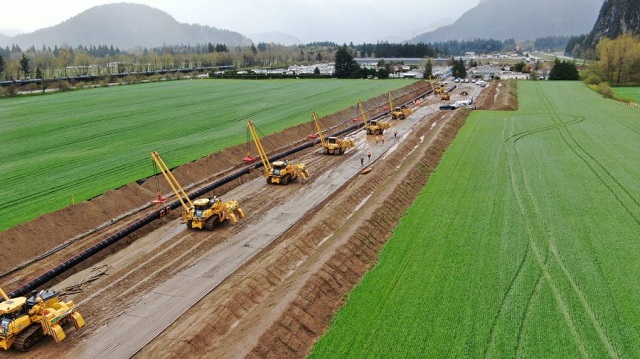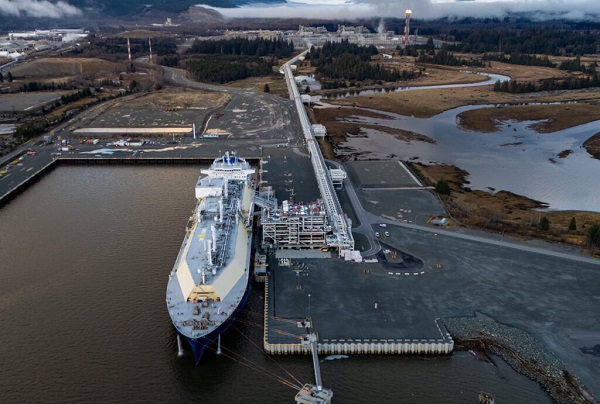Energy
Transmountain Pipeline Expansion Project a success?

From the Frontier Centre for Public Policy
The Transmountain Mountain Pipeline expansion project (TMEP) was completed on May 01, 2024. Its startup the following month ended an eleven-year saga of tectonic federal energy policy initiatives, climate change requirements, federal regulatory restructuring, and indigenous reconciliation. That it was finished at all is a triumph, but there was muted celebration.
The original proponent for TMEP was Kinder Morgan (KM), who filed its application with the federal energy regulator in 2013. The expansion would be constructed in the existing right of way of the existing pipeline and increase capacity from 300,000 barrels of oil and refined products to 890,000 barrels of oil per day. This included expansion of the existing dock and loading facilities. Protests began virtually the next day. The cost estimate at that time was $7.4 billion for the 1,150 km pipeline and related facilities. The federal regulator and the federal government approved the project in 2016.
Between 2016 and 2018, the intensity of the protests against TMEP and a new government formed in British Columbia that vowed it would use any means possible to make sure TMX would not be built created significant hurdles. KM warned that the protest’s impact and B.C.’s regulatory and legal challenges were creating significant uncertainty, and the project would be delayed at least a year, stopping all non-essential spending. Ultimately KM decided it would not continue with the project because of the increased execution risk and cost to complete the project that the legal and regulatory challenges, and increasing protests, posed.
The project’s shelving by KM led to the federal government acquiring all the Kinder Morgan assets, including TM for $4.7 billion in 2018. Construction then began in 2019. The execution risks remained the same with the legal and regulatory challenges. They were compounded by a legal challenge to the substance of the federal government’s consultation with indigenous people, which was their constitutional duty. The courts agreed that the federal government had not met its constitutional duty to consult and ordered that it be redone. This led to further delays and in 2020 the cost estimate increased to $12.6 billion, then increased again to $21.4 billion in 2022. Ultimately, the federal regulator imposed 157 conditions on TMEP that it had to meet before it could operate.
COVID, extensive flooding and regulatory delays led to a further cost increase up to $30.9 billion in 2023. The final updated cost increased to $34 billion in 2024 due to labour costs, inflation, and materials delays.
The foregoing “Coles notes” version of events sets out the challenges endured by TMX as of Thursday, May 23, 2024. It also highlights that delays in a major project like TMEP have a massive impact on costs. But what gets lost in all this is that in 2013 KM, a public company, made a commercial decision to proceed with the project. There was and still is a huge market pull for the pipeline and the incremental oil volumes. There is huge economic and strategic value for Canada that will benefit all sectors of the economy and indigenous communities, who will most likely end with significant pipeline ownership.
Market access for Canada’s oil production in the Pacific markets will change the oil trading dynamics and value for Canadian production. Canada has the third largest oil reserves in the world. Canada is among the best in its class for environmental, safety, social and governance of its energy production. Canada is also among the best in pipeline construction and safety. So, who best to execute a monumental project like TMX?
We need to reflect and admire the skill, diligence, and perseverance of everyone involved with bringing to fruition TMX as a world class, state of the art major piece of energy infrastructure.
Yes, TMX is a success but the process through which it had to persevere was a failure and we should reflect and learn from it. In the end, despite the final cost, Canada will reap the economic benefits from TMX for decades because the world needs oil and Canada has lots of it.
Chris Bloomer is a board member of FCPP and the former president and CEO of the Canadian Energy Pipeline Association. He has held senior executive positions in the energy industry in Canada and internationally.
Daily Caller
Trump Floats Reimbursing Oil Companies If They Put Up Big Bucks In Venezuela


From the Daily Caller News Foundation
Following the removal of socialist dictator Nicolás Maduro, President Donald Trump said the U.S. government might reimburse oil companies that invest in Venezuela.
In a Monday afternoon phone interview, Trump told NBC News’ Kristen Welker that an expansion of the U.S. oil industry in the South American nation could be “up and running” in less than a year and a half, but this would require “a lot of money.” Hours after announcing Maduro’s capture Saturday, Trump said in a press conference that the U.S. is going to “run” Venezuela until there could be “a safe, proper and judicious transition” — a remark that sparked much discussion over exactly what will come next for the country.
“A tremendous amount of money will have to be spent, and the oil companies will spend it, and then they’ll get reimbursed by us or through revenue,” Trump said in his interview with Welker, referring to rebuilding the beleaguered oil infrastructure in post-Maduro Venezuela.
The president did not specify how much money is required for oil companies to upgrade the infrastructure, NBC News reported. Trump previously said he was going to “have our very large United States oil companies, the biggest anywhere in the world, go in, spend billions of dollars, fix the badly broken infrastructure and start making money for the country.”
“It’ll be a very substantial amount of money [that] will be spent,” Trump added in his interview with Welker. “But they’ll [the oil companies will] do very well. And the country will do well.”
Trump told the NBC News host that Venezuela producing oil is “good for the United States because it keeps the price of oil down.”
He also told Welker that his administration did not brief oil companies before carrying out the surprise attack that deposed Maduro.The companies, though, “were absolutely aware that we were thinking about doing something.”
Welker, on NBC News’ “Meet The Press” Sunday, asked Secretary of State Marco Rubio, “Why does the United States need to take over the Venezuelan oil industry?”
“We don’t need to. We don’t need Venezuela’s oil,” Rubio said. “We have plenty of oil in the United States. What we’re not going to allow is for the oil industry in Venezuela to be controlled by adversaries of the United States.”
“Why does China need their oil? Why does Russia need their oil? Why does Iran need their oil?” the Secretary of State asked. “They’re not even in this continent. This is the Western Hemisphere. This is where we live.”
Also on Sunday, a Venezuelan man in Buenos Aires, Argentina went viral while celebrating the end of the Mauro regime, after he pushed back against critics who said the U.S. is only interested in Venezuela due to its status as an oil-producing country.
“Those who say that the U.S. is only interested in our oil, I ask you: What do you think the Russians and the Chinese wanted here? The recipe for arepas?” the man asked in Spanish, naming a popular street food in Venezuelan cuisine. “Impossible.”
Energy
The global math: Why exporting Canadian energy is a climate win

From Resource Works
New report finds that displacing coal and foreign gas with Canadian LNG could lower global emissions by 70 megatonnes a year
Canada’s energy policy debate has become trapped in a polarization that feels dangerously disconnected from global reality.
On one side, we have a domestic conversation focused intensely on our own emissions ledger—counting every tonne produced within our borders as a liability. On the other side is the global reality: a world hungry for energy, often turning to the dirtiest sources available to keep the lights on and economies growing.
I’ve long argued that we cannot solve a global problem like climate change by wearing blinders that restrict our view to the 49th parallel. Recently, on the Power Struggle podcast, I sat down with Mark Cameron to discuss the hard data that backs this up.
Cameron is a fellow at the Public Policy Forum and the co-author of a new report Refuel: What Canadian LNG and Oil Exports Could Mean for Global Emissions. The numbers tell a story that might surprise those who view energy exports solely as a climate negative.
Flipping the script on emissions
The central finding of the Refuel report challenges the orthodoxy that “more production equals more pollution.” When we look at the global picture, the opposite appears to be true.
“The headline news is that if Canada was to increase its LNG exports by [47 million tonnes a year] and if we are exporting primarily into Asian markets, there would be a net reduction in emissions of about 40 to 70 megatonnes per year,” Cameron told me.
Let that sink in. By increasing our economic output and shipping more product abroad, we could lower global emissions by an amount roughly equivalent to taking millions of cars off the road.
It comes down to displacement. The energy we export doesn’t vanish into a void; it replaces other, often dirtier, forms of power generation.
“In some of those markets, you’re displacing coal,” Cameron explained. “Coal obviously is about twice the emissions in generating electricity as LNG. So to the extent that you’re displacing coal, you’re getting a clear emissions reduction.”
The Canadian advantage
This isn’t just about the inherent chemistry of gas versus coal. It is also about the specific quality of the gas produced in Western Canada. Not all liquefied natural gas (LNG) is created equal.
Canada’s geography and technology provide a distinct edge over competitors regarding carbon intensity.
“Canadian LNG, because it has cooler temperatures, shorter shipping times to Asia, more electric drive in its production, is actually about 35 per cent lower in emissions than LNG that would be shipped from, say, the U.S. Gulf Coast,” Cameron said.
When we debate blocking a Canadian project, we act as if the alternative is zero consumption. But the alternative is often gas from the Gulf Coast—which requires more energy to cool in the hot southern climate and takes longer to ship—or worse, coal.
Asian markets know this. They are looking for reliability and lower carbon intensity.
“We want to have a certain percentage of LNG, and we want a certain percentage of that coming from Canada because it’s a stable market and it has a particularly low emissions intensity,” Cameron noted.
The reality of substitution
This brings us to the concept of “carbon leakage.” It is a harsh economic reality that if Canada steps out of the market, we don’t save the planet—we simply cede market share to those with lower environmental standards.
“If the LNG is not coming from Canada, it’s going to come from somewhere else,” Cameron said bluntly. “It’s going to come from the U.S. or Qatar or Australia, or it would be displaced by coal or another energy source. So when you look at all those things in balance, it does look like Canadian LNG is a net positive for the climate.”
Progress in the oilsands
While LNG often dominates the “transition fuel” conversation, the report also addresses the oilsands. The narrative there has often ignored massive strides in efficiency.
“That emissions intensity is coming down. It’s come down by about 30 per cent in the last 20 years,” Cameron said.
He pointed to operational fuel switching as a key driver of this progress.
“Canadian oilsands was using petroleum coke, essentially coal, to generate the steam for the oilsands production. That is almost entirely shifted to natural gas.”
The long game
Finally, we must address the timeline. Critics argue that building LNG infrastructure locks us into fossil fuels. But the transition is a decades-long process.
“There is going to be LNG demand,” Cameron said. “We don’t know exactly how much, but there’s going to be LNG demand for the next four or five, six decades.”
Furthermore, natural gas is a fundamental building block of modern civilization, used for fertilizer and chemical production, not just electricity.
“If we can produce the cleanest LNG in the world, we’re actually doing global climate a favour by building those projects,” Cameron added.
If we retreat from the world stage, we aren’t taking the moral high ground; we are merely outsourcing the emissions to countries with a heavier carbon footprint. A Canada that exports more is a Canada that contributes to a cleaner world.
Watch the video on Power Struggle
- Power Struggle audio and transcript
- Mark Cameron on LinkedIn
- Stewart Muir on X
- Stewart Muir on LinkedIn
Power Struggle on social media:
-

 Frontier Centre for Public Policy1 day ago
Frontier Centre for Public Policy1 day agoIs Canada still worth the sacrifice for immigrants?
-

 Bruce Dowbiggin1 day ago
Bruce Dowbiggin1 day agoThe Olympic Shutout: No Quebec Players Invited For Canada
-

 Canadian Energy Centre1 day ago
Canadian Energy Centre1 day agoFive reasons why 2026 could mark a turning point for major export expansions
-

 International1 day ago
International1 day agoNetwork of Nonprofits with Marxist and CCP Ties, and Elected Socialists Race to Counter Washington’s Narrative of the Maduro Raid
-

 Alberta1 day ago
Alberta1 day agoTrump’s Venezuela Geopolitical Earthquake Shakes up Canada’s Plans as a “Net Zero” Energy Superpower
-

 Business1 day ago
Business1 day agoPolicy uncertainty continues to damage Canada’s mining potential
-

 Environment1 day ago
Environment1 day agoLeft-wing terrorists sabotage German power plant, causing massive power outage
-

 Energy1 day ago
Energy1 day agoTrump’s Venezuela Move: A $17 Trillion Reset of Global Geopolitics and a Pivotal Shift in US Energy Strategy



